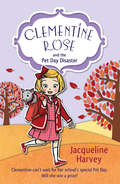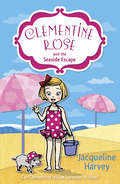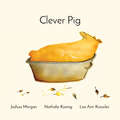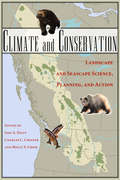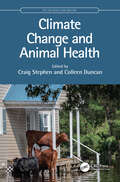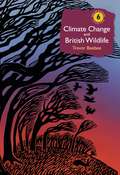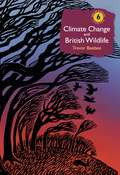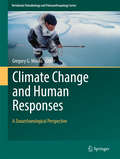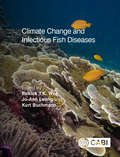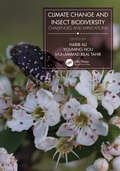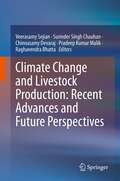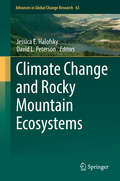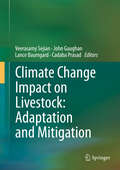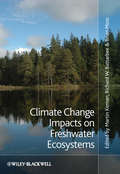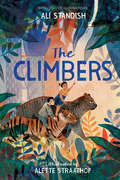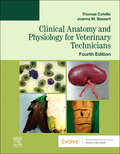- Table View
- List View
Clementine Rose and the Pet Day Disaster (Clementine Rose #2)
by Jacqueline HarveyClementine Rose is so excited to be going to school for the first time! Especially when her new teacher tells her about the Pet Day coming up soon. But will Clementine Rose be allowed to bring her teacup pig Lavender into school - and could the two of them even win a prize?
Clementine Rose and the Seaside Escape (Clementine Rose #5)
by Jacqueline HarveyClementine Rose is off to the seaside! She makes a new friend as soon as she arrives: Freddy, who takes her exploring in the beach caves, where they discover an exciting, wonderful secret.But then Clemmie's tiny teacup pig, Lavender, escapes during a storm - and it's all hands on deck to bring her home safe and sound.
Clever Dog: The Secrets Your Dog Wants You To Know
by Sarah WhiteheadMan is not ape. Dog is not wolf.
Clever Pig
by Nathalie KoenigPig loves to play! Clever Pig One day, Pig is gone. Will Pig come back? Josh Morgan (illustrator), Lee-Ann Knowles (designer), Carol Kagezi (editor).
Climate and Conservation: Landscape and Seascape Science, Planning, and Action
by Jodi A. Hilty, Charles C. Chester and Molly S. CrossClimate and Conservation presents case studies from around the world of projects focused on climate change adaptation-regional-scale endeavors where scientists, managers, and practitioners are working to protect biodiversity by protecting landscapes and seascapes in response to threats posed by climate change.The book begins with an introductory section that frames the issues and takes a systematic look at planning for climate change adaptation. The nineteen chapters that follow examine particular case studies in every part of the world, including landscapes and seascapes from equatorial, temperate, montane, polar, and marine and freshwater regions.Climate and Conservation offers readers tangible, place-based examples of projects designed to protect large landscapes as a means of conserving biodiversity in the face of the looming threat of global climate change.
Climate Change and Animal Health (CRC One Health One Welfare)
by Craig Stephen Colleen DuncanThis benchmark publication assembles information on the current and anticipated effects of climate change on animal health. It empowers educators, managers, practitioners, and researchers by providing evidence, experience, and opinions on what we need to do to prepare for, and cope with, the largest threat ever to have faced animals on this planet. With expert contributors from across the globe, the text equips the reader with information and means to develop sustainable adaptation or mitigation actions. After introducing animal health in a climate change context, chapters look at specific animal health impacts arising from climate change. The book concludes with suggestions on teachable and actionable ideas that could be used to mobilize concepts provided into education or advocacy. This book was written amid the COVID-19 pandemic and in the face of ever-increasing reports of on-the-ground, real-life climate impacts. Large scale wildfire and ocean heat waves killed unprecedented numbers of animals while droughts in some areas and floods in others displaced thousands of livestock and made food scarce for even more. Climate change is real, and it is here. How we respond will have profound implications for people, biodiversity, welfare, conservation, societies, economies and ecosystems. Today's veterinary educators are awakening to the need to adapt and train a new generation of animal health professions who can understand and plan for climate change, and this book is an essential resource.
Climate Change and Animal Health (CRC One Health One Welfare)
by Craig Stephen Colleen DuncanThis benchmark publication assembles information on the current and anticipated effects of climate change on animal health. It empowers educators, managers, practitioners, and researchers by providing evidence, experience, and opinions on what we need to do to prepare for, and cope with, the largest threat ever to have faced animals on this planet. With expert contributors from across the globe, the text equips the reader with information and means to develop sustainable adaptation or mitigation actions. After introducing animal health in a climate change context, chapters look at specific animal health impacts arising from climate change. The book concludes with suggestions on teachable and actionable ideas that could be used to mobilize concepts provided into education or advocacy. This book was written amid the COVID-19 pandemic and in the face of ever-increasing reports of on-the-ground, real-life climate impacts. Large scale wildfire and ocean heat waves killed unprecedented numbers of animals while droughts in some areas and floods in others displaced thousands of livestock and made food scarce for even more. Climate change is real, and it is here. How we respond will have profound implications for people, biodiversity, welfare, conservation, societies, economies and ecosystems. Today's veterinary educators are awakening to the need to adapt and train a new generation of animal health professions who can understand and plan for climate change, and this book is an essential resource.
Climate Change and British Wildlife (British Wildlife Collection)
by Trevor Beebee“Fascinating but frightening, compelling and concerning … this book brings together all you need to know about how the climate is impacting wildlife.”CHRIS PACKHAMThere is no escaping the fact that the British climate is changing, and our wildlife is changing with it. In this remarkable account, Trevor Beebee examines the story so far for our plant, fungi and animal species. Warmer and wetter winters, combined with longer summers, have worked to the advantage of plants such as the rare Lady Orchid,and a whole range of insects. The UK is also hosting new arrivals that come in on the wing. But there is adversity, too. Alpine plants and seabirds – particularly Kittiwakes – are suffering declines as our countryside warms. Given the evidence so far, can we predict what the future holds for our British ecosystems?
Climate Change and British Wildlife (British Wildlife Collection)
by Trevor Beebee“Fascinating but frightening, compelling and concerning … this book brings together all you need to know about how the climate is impacting wildlife.”CHRIS PACKHAMThere is no escaping the fact that the British climate is changing, and our wildlife is changing with it. In this remarkable account, Trevor Beebee examines the story so far for our plant, fungi and animal species. Warmer and wetter winters, combined with longer summers, have worked to the advantage of plants such as the rare Lady Orchid,and a whole range of insects. The UK is also hosting new arrivals that come in on the wing. But there is adversity, too. Alpine plants and seabirds – particularly Kittiwakes – are suffering declines as our countryside warms. Given the evidence so far, can we predict what the future holds for our British ecosystems?
Climate Change and Human Responses: A Zooarchaeological Perspective (Vertebrate Paleobiology and Paleoanthropology)
by Gregory MonksThis book contributes to the current discussion on climate change by presenting selected studies on the ways in which past human groups responded to climatic and environmental change. In particular, the chapters show how these responses are seen in the animal remains that people left behind in their occupation sites. Many of these bones represent food remains, so the environments in which these animals lived can be identified and human use of those environments can be understood. In the case of climatic change resulting in environmental change, these animal remains can indicate that a change has occurred, in climate, environment and human adaptation, and can also indicate the specific details of those changes.
Climate Change and Infectious Fish Diseases
by Patrick T.K. Woo Jo-Ann Leong Kurt BuchmannClimate change with global warming is not disputed by the vast majority of scientists and the aquatic system is most affected. A global rise in water temperature and acidification of the aquatic environment will continue even if we can significantly reduce the current output of the two most important greenhouse gasses (carbon dioxide and methane). These and other environmental changes will affect fish health which includes infectious pathogens. This important new text is the second volume on climate change and fish health. It covers changes to the freshwater ecosystem and their current and expected effects on selected infectious diseases of fish. The book represents contributions by over 50 experts from 18 countries. Comprehensive and thought-provoking, the book details abiotic and biotic environmental changes in temperate and tropical freshwater ecosystems, sequestrations of atmospheric carbon dioxide and effects on infectious diseases (12 microbial and 10 parasitic) in economically important fish in tropical, subtropical and temperate waters. The text is key reading for fish disease scientists, aquatic ecologists, fish health consultants, veterinarians, policy makers and all who are interested in fish health and the environment.
Climate Change and Insect Biodiversity: Challenges and Implications
by Habib Ali Youming Hou Muhammad Bilal TahirThis up-to-date reference book discusses the effects of climate change on the biodiversity of insect pests. The changing climate and agricultural intensification practices impact negatively on insect biodiversity. The book explains the significance of insect pests for evaluating climatic impacts on a wide range of ecological systems. It covers the effect of climate change on pollinators and household and agricultural insect pests. It explains how climate-smart agriculture can enhance productivity and food security.FEATURES Reviews the effects of climate change on plant-insect interactions Includes topics such as insect biodiversity informatics and conservation Discusses food security, pest management, and beneficial and social insects Covers topics such as precision agriculture and climate-smart agriculture Provides insights on the relation between agriculture intensification and insect biodiversity This book is meant for scientists, researchers, and students working in the fields of agriculture, entomology, ecology, plant science, environmental biology, and biotechnology.
Climate Change and Insect Biodiversity: Challenges and Implications
This up-to-date reference book discusses the effects of climate change on the biodiversity of insect pests. The changing climate and agricultural intensification practices impact negatively on insect biodiversity. The book explains the significance of insect pests for evaluating climatic impacts on a wide range of ecological systems. It covers the effect of climate change on pollinators and household and agricultural insect pests. It explains how climate-smart agriculture can enhance productivity and food security.FEATURES Reviews the effects of climate change on plant-insect interactions Includes topics such as insect biodiversity informatics and conservation Discusses food security, pest management, and beneficial and social insects Covers topics such as precision agriculture and climate-smart agriculture Provides insights on the relation between agriculture intensification and insect biodiversity This book is meant for scientists, researchers, and students working in the fields of agriculture, entomology, ecology, plant science, environmental biology, and biotechnology.
Climate Change and Livestock Production: Recent Advances and Future Perspectives
by Veerasamy Sejian Surinder Singh Chauhan Chinnasamy Devaraj Pradeep Kumar Malik Raghavendra BhattaThis book describes the importance of sustainable livestock production from a food security perspective in the changing climate scenario. It covers the amelioration of climate change impacts and describes the various mitigation strategies to reduce enteric methane emissions. The book targets sustainable livestock production by covering diverse concepts of amelioration, mitigation, and policy up-gradation. Further, it examines various adverse impacts of climate change on growth, meat, milk, and reproduction in livestock. Most importantly, the book covers novel aspects of quantifying heat stress response of livestock based on non-invasive methodologies, including infrared thermal imaging, sensor-based applications, hair, urine, and fecal cortisol estimation. Particular emphasis was given to describing the skin-based novel approaches to establish climate resilience in indigenous breeds. The book provides detailed descriptions of alleviating climate change impacts on shelter management, nutritional interventions, and genetics-based strategies involving advanced genomic tools. Lastly, it highlights the livestock species which could be considered ideal climate-resilient animal models to withstand the adversities associated with climate change.
Climate Change and Rocky Mountain Ecosystems (Advances in Global Change Research #63)
by Jessica Halofsky David L. PetersonThis book is the result of a team of approximately 100 scientists and resource managers who worked together for two years to understand the effects of climatic variability and change on water resources, fisheries, forest vegetation, non-forest vegetation, wildlife, recreation, cultural resources and ecosystem services. Adaptation options, both strategic and tactical, were developed for each resource area. This information is now being applied in the northern rocky Mountains to ensure long-term sustainability in resource conditions.The volume chapters provide a technical assessment of the effects of climatic variability and change on natural and cultural resources, based on best available science, including new analyses obtained through modeling and synthesis of existing data. Each chapter also contains a summary of adaptation strategies (general) and tactics (on-the-ground actions) that have been developed by science-management teams.
Climate Change Impact on Livestock: Adaptation and Mitigation
by Veerasamy Sejian John Gaughan Lance Baumgard Cadaba PrasadThis volume addresses in detail both livestock’s role in climate change and the impacts of climate change on livestock production and reproduction. Apart from these cardinal principles of climate change and livestock production, this volume also examines the various strategies used to mitigate livestock-related GHG emissions, and those which can reduce the impacts of climate change on livestock production and reproduction. Presenting information and case studies collected and analyzed by professionals working in diversified ecological zones, the book explores the influence of climate change on livestock production across the globe. The most significant feature of this book is that it addresses in detail the different adaptation strategies and identifies targets for different stakeholders in connection with climate change and livestock production. Further, it puts forward development plans that will allow the livestock industries to cope with current climate changes and strategies that will mitigate the effects by 2025. Lastly, it provides researchers and policymakers several researchable priorities to help develop economically viable solutions for livestock production with less GHG emissions, promoting a cleaner environment in which human beings and livestock can live in harmony without adverse effects on productivity.Given that livestock production systems are sensitive to climate change and at the same are themselves a contributor to the phenomenon, climate change has the potential to pose an increasingly formidable challenge to the development of the livestock sector. However, there is a dearth of scientific information on adapting livestock production to the changing climate; as such, well-founded reference material on sustaining livestock production systems under the changing climate scenarios in different agro-ecological zones of the world is essential. By methodically and extensively addressing all aspects of climate change and livestock production, this volume offers a valuable tool for understanding the hidden intricacies of climatic stress and its influence on livestock production.
Climate Change Impacts on Freshwater Ecosystems
by Martin KernanThis text examines the impact of climate change on freshwater ecosystems, past, present and future. It especially considers the interactions between climate change and other drivers of change including hydromorphological modification, nutrient loading, acid deposition and contamination by toxic substances using evidence from palaeolimnology, time-series analysis, space-for-time substitution, laboratory and field experiments and process modelling. The book evaluates these processes in relation to extreme events, seasonal changes in ecosystems, trends over decadal-scale time periods, mitigation strategies and ecosystem recovery. The book is also concerned with how aspects of hydrophysical, hydrochemical and ecological change can be used as early indicators of climate change in aquatic ecosystems and it addresses the implications of future climate change for freshwater ecosystem management at the catchment scale. This is an ideal book for the scientific research community, but is also accessible to Masters and senior undergraduate students.
Climate Change Impacts on Freshwater Ecosystems
by Martin Kernan Richard W. Battarbee Brian R. MossThis text examines the impact of climate change on freshwater ecosystems, past, present and future. It especially considers the interactions between climate change and other drivers of change including hydromorphological modification, nutrient loading, acid deposition and contamination by toxic substances using evidence from palaeolimnology, time-series analysis, space-for-time substitution, laboratory and field experiments and process modelling. The book evaluates these processes in relation to extreme events, seasonal changes in ecosystems, trends over decadal-scale time periods, mitigation strategies and ecosystem recovery. The book is also concerned with how aspects of hydrophysical, hydrochemical and ecological change can be used as early indicators of climate change in aquatic ecosystems and it addresses the implications of future climate change for freshwater ecosystem management at the catchment scale. This is an ideal book for the scientific research community, but is also accessible to Masters and senior undergraduate students.
Climate Change, Ocean Acidification and Sponges: Impacts Across Multiple Levels of Organization
by José Luis Carballo James J. BellWhile sponges represent a very simple group of organisms, which are represented by over 8000 species, there is considerable interest in the increasing role they may play in future marine ecosystems. While we still have a comparatively limited understanding of how sponges will respond to ocean warming and acidification there is evidence that some species may have the ability to acclimate or even adapt to these stressors. This comprehensive collection of articles describes our current understanding of the impacts of ocean acidification and warming on sponges across multiple levels of biological organisation, and from the geological past to the present. With expert contributions from across the world this book represents the most up-to-date view on sponge responses to climate change. This book will be of interest to a wide audience of marine scientists and managers, who are grappling with how to manage, conserve and protect marine ecosystems.
Climate, Ticks and Disease (CABI Climate Change Series #18)
by Saeed Alasmari Neil Alexander Abdelghafar Alkishe Reiko Arai Armanda Bastos Gervasio Henrique Bechara John Beier Giovanni Benelli Joshua Benoit Dennis Bente Richard Bishop Adrien Blisnick René Bødker Fernando Boinas Sarah Bonnet Nathalie Boulanger Alejandro Cabezas-Cruz Alexandre Rodrigues Caetano Cyril Caminade Jirí Cerny´ Roxanne Albertha Charles Ali Reza Chavshin Rosalind Cornforth Neil Coughlan Peter Cox Lauren Culler Milan Daniel Vlasta Danielova Mona Dehhaghi Maria Diuk-Wasser James P Duffy Olivier Duron Lars Eisen Rebecca Eisen Jana Elsterová Koray Ergünay Agustín Estrada-Peña Li-Qun Fang Natalia Fernández-Ruiz Erol Fikrig Serhii Filatov Durland Fish Janet Foley José De Fuente Roman Ganta Aysen Gargili Keles Robin Beat Gasser Abdul Ghafar Naftaly Githaka Lucy Gilbert Maryna Golovchenko Yuval Gottlieb Ernest Gould Jeremy Gray Libor Grubhoffer Gilles J. Guillemin Kayleigh M. Hansford Charles Hart John E. Healy Deborah Hemming Stephen Higgs Andrew Hoodless Yan-Jang S. Huang Bernard Hudson Chris Huntingford Peter Irwin Abdul Jabbar Nicholas Johnson Esther Kanduma Sirri Kar Maria Kazimirova Neil Kaye Thomas C. Kelly Lene Jung Kjaer Agatha Onyemowo Kolo Eduard Korenberg Nina Król Chi-Chien Kuo Timothy J. Kurtti Xavier De Lamballerie Patrick A. Leighton Hao Li L. Robbin Lindsay Wei Liu Geoffrey E. Lynn Ilya Maclean Ben J. Mans Maristela Martins de Camargo Karen D. McCoy Jolyon M. Medlock Ulrike G. Munderloh Atle Mysterud Sukanya Narasimhan Anna Obiegala Dasiel Obregón Alvarez Dr Nick H. Ogden Mari H. Ogihara Stefan Vilges Oliveira Charlotte Oskam Domenico Otranto Kennan J. Oyen Neha Pandey Hamed Kazemi Panahi A. Townsend Peterson John H. Pettersson Martin Pfeffer L. Paul Phipps Heather J. Plumpton Tatjana Pustahija Ram Raghavan Ryan O.M Rego Annapaola Rizzoli Isobel Ronai Franz Rubel Natalie Rudenko Benjamin Ruiwen Rufus Sage Abdallah M. Samy Gustavo Seron Sanches Isabel Kinney Santos Marcello Otake Sato Megumi Sato Richard Schloeffel Seyyed Javad Seyyed-Zadeh Ladislav Šimo Sunit Kumar Singh Daniel E. Sonenshine Morgan Sparey Frederic Stachurski Snorre Stuen Matias Pablo Szabó DeMar Taylor Mike Teglas Sam R. III Saravanan Thangamani Georgia Titcomb Attila J. Trájer Michael Turell Rika Umemiya-Shirafuji Dana L. Vanlandingham Laurence Vial Margarita Villar Richard Wall André B. Wilke G. R. Wint Jianhong Wu Zbigniew Zajac Xue ZhangThis book brings together expert opinions from scientists to consider the evidence for climate change and its impacts on ticks and tick-borne infections. It considers what is meant by 'climate change', how effective climate models are in relation to ecosystems, and provides predictions for changes in climate at global, regional and local scales relevant for ticks and tick-borne infections. It examines changes to tick distribution and the evidence that climate change is responsible. The effect of climate on the physiology and behaviour of ticks is stressed, including potentially critical impacts on the tick microbiome. Given that the notoriety of ticks derives from pathogens they transmit, the book considers whether changes in climate affect vector capacity. Ticks transmit a remarkable range of micro- and macro-parasites many of which are pathogens of humans and domesticated animals. The intimacy between a tick-borne agent and a tick vector means that any impacts of climate on a tick vector will impact tick-borne pathogens. Most obviously, such impacts will be apparent as changes in disease incidence and prevalence. The evidence that climate change is affecting diseases caused by tick-borne pathogens is considered, along with the potential to make robust predictions of future events. This book contains: Expert opinions and predictions. Global coverage of trends in ticks and disease. In-depth examination of climate change and tick distribution links. This book is suitable for researchers and students studying zoology, biological sciences, medical entomology, animal health, veterinary medicine, epidemiology, parasitology, and climate change impacts; and for those concerned with public health planning or livestock management where ticks and tick-borne pathogens pose a threat.
The Climbers (Colour Fiction #3)
by Ali StandishLonely Alma longs to explore the lush forest beyond her narrow town, but her uncle has told her it’s full of fearsome beasts. One night, she ventures into the trees and finds a frightened bear cub. The two become friends but the rest of the town is not so welcoming. Soon, Alma and Star Bear are forced to set off in search of a place to call home. A lyrical tale about a tender friendship that triumphs over fear, with colour illustrations on every page.
Clinical Anatomy and Physiology for Veterinary Technicians - E-Book
by Joanna M. Bassert Thomas P. ColvilleStart your veterinary technician education off on the right foot with Clinical Anatomy and Physiology for Veterinary Technicians, 3rd Edition. Combining expert clinical coverage with engaging writing and vivid illustrations, this popular text is the key to helping you understand the anatomic and physiologic principles that will carry you throughout your career. In addition to its comprehensive coverage of the diverse ways in which animal bodies function at both the systemic and cellular levels, the new third edition features a variety of helpful application boxes, vocabulary lists, and Test Yourself questions in every chapter to ensure you have a firm grasp of anatomic structure and its relevance to clinical practice.High quality, full color illustrations highlight the details of anatomic structure to enhance understanding of anatomy functions.Chapter outlines summarize the contents of each chapter at the major concept level.Clinical Application boxes throughout the text demonstrate the clinical relevance of anatomic and physiologic principles. Test Yourself questions recap important information that appeared in the preceding section. Comprehensive glossary at the end of the text provides concise definitions and phonetic pronunciations of terms.NEW! Vocabulary Fundamentals list of terms at the beginning of each chapter introduce readers to new scientific terms and their pronunciations.
Clinical Anatomy and Physiology for Veterinary Technicians - E-Book
by Thomas P. Colville Joanna M. BassertStart your veterinary technician education off on the right foot with Clinical Anatomy and Physiology for Veterinary Technicians, 4th Edition. Combining expert clinical coverage with engaging writing and vivid illustrations, this popular text is the key to understanding the anatomic and physiologic principles that will carry you throughout your career. In addition to its comprehensive coverage of the diverse ways in which animal bodies function at both the systemic and cellular levels, this textbook features a variety of helpful application boxes, vocabulary lists, and Test Yourself questions in every chapter to ensure you have a firm grasp of anatomic structure and its relevance to clinical practice. Clinical Application boxes throughout the text demonstrate the clinical relevance of anatomic and physiologic principles. Chapter outlines summarize the contents of each chapter at the major concept level. Test Yourself questions recap important information that appeared in the preceding section. Comprehensive glossary at the end of the text provides concise definitions and phonetic pronunciations of terms. NEW and UPDATED! Hundreds of high-quality, full color illustrations detail anatomic structures to enhance your understanding of their functions. NEW! Student chapter review questions on the Evolve companion website help reinforce key topics in each chapter.
Clinical Aspects of Hearing (Springer Handbook of Auditory Research #7)
by Richard R. Fay Arthur N. Popper Thomas R. WaterThe Springer Handbook of Auditory Research presents a series of com prehensive and synthetic reviews of the fundamental topics in modem auditory research. It is aimed at all individuals with interests in hearing research including advanced graduate students, postdoctoral researchers, and clinical investigators. The volumes will introduce new investigators to important aspects of hearing science and will help established investigators to better understand the fundamental theories and data in fields of hearing that they may not normally follow closely. Each volume is intended to present a particular topic comprehensively, and each chapter will serve as a synthetic overview and guide to the literature. As such, the chapters present neither exhaustive data reviews nor original research that has not yet appeared in peer-reviewed journals. The series focuses on topics that have developed a solid data and conceptual foundation rather than on those for which a literature is only beginning to develop. New research areas will be covered on a timely basis in the series as they begin to mature. Each volume in the series consists of five to eight substantial chapters on a particular topic. In some cases, the topics will be ones of traditional interest for which there is a solid body of data and theory, such as auditory neuroanatomy (Vol. 1) and neurophysiology (Vol. 2). Other volumes in the series will deal with topics which have begun to mature more recently, such as development, plasticity, and computational models of neural processing.
Clinical Atlas of Canine and Feline Dermatology
by Kimberly S. CoynerClinical Atlas of Canine and Feline Dermatology presents more than a thousand high-quality color photographs depicting common dermatologic diseases and conditions, making it easy for clinicians to quickly evaluate and accurately identify clinical dermatologic lesions. Easy-to-use charts of dermatologic diseases provide differential diagnoses and treatments, helping practitioners to quickly find the most common differential diagnoses, perform appropriate diagnostics, and treat their patients. Written by experienced veterinary dermatologists, the book begins with chapters on essential dermatologic diagnostics and identification and interpretation of skin lesions, featuring pictorial illustrations with commentary of the most common causes. Diagnostic algorithms for pruritus and alopecia simplify the workup of these very common presenting symptoms, and easily referenced tables detail the presentation, diagnosis, and management of hundreds of skin diseases. The book also offers a dermatologic formulary including systemic and topical therapies. Provides more than 1200 images showing the most encountered dermatologic conditions in dogs and cats Includes easy-to-interpret charts of differential diagnoses and treatments Offers diagnostic and treatment algorithms for the most common skin diseases in dogs and cats Presents details of the presentation, diagnosis, and management of hundreds of skin diseases in tables for quick reference Features video clips on a companion website demonstrating dermatologic diagnostic techniques, including skin scrapings and cytology, aspiration of skin masses for cytology, and biopsy Offering fast access to practical information for diagnosing and treating dermatologic disease in small animal practice, Clinical Atlas of Canine and Feline Dermatology is an essential book for any small animal practitioner or veterinary student.
